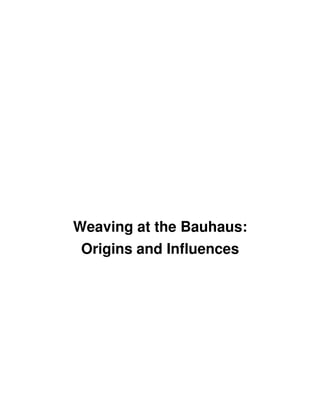This document provides an overview of the origins and influences of weaving at the Bauhaus school in Germany from 1919-1933. It discusses precursors like the Arts and Crafts movement and German Expressionism. It describes the establishment of the Weaving Workshop and its curriculum. Key weavers like Anni Albers produced innovative textile designs that integrated art and craft and emphasized function over decoration. The Bauhaus weaving tradition had lasting influence on textile design in the 20th century.






























![Bibliography
Adams, Laurie Schneider. Art Across Time, Volume II. McGrawHill College, 1999.
The Alma Conservancy. Alma: Life and Works. <http://www.almaconservancy.org/>
AngeloTesta.com. AngeloTesta.com. 2000. <http://www.angelotesta.com/>
‘Bauhaus’, The Grove Dictionary of Art Online, (Oxford University Press, Accessed [22 10 2003])
<http://www.groveart.com>
BauhausArchiv Museum of Design. BauhausArchiv Museum of Design. 1999.
<http://www.bauhaus.de/english/bauhausarchiv/index.htm>
Black Mountain College Museum & Arts Center. Black Mountain College Museum & Arts Center.
19992003. <http://www.blackmountaincollege.org/>
Bradley, Louise, and Budd, Ann Walker. "Profile: Else Regensteiner." Handwoven, November/December,
1990, pp. 7072.
deAtley, Suzanne. "The Weaving Legacy of the Arts and Crafts Movement in America. Handwoven,
November/December 1995, pp. 3643.
Farr, Christopher. Original Contemporary Design Rugs and Carpets. October, 2000.
<http://www.cfarr.co.uk/past_exhibitions2.htm>
Garner, Ann. The Bauhaus Weaving Workshop. September 21, 1999.
<http://www.suite101.com/article.cfm/4010/25884>
‘Germany, XI, 5: Other textiles, The Bauhaus’, The Grove Dictionary of Art Online, (Oxford University
Press, Accessed [22 10 2003]) <http://www.groveart.com>
GertenJackson, Carol. CGFA: Wassily Kandinsky: Moscow 1. July 31, 2002.
<http://cgfa.sunsite.dk/kandinsky/pkandinsky13.htm>
Grotta, Tom. kay sekimachi/browngrotta.com. 2002.
<http://browngrotta.com/bgarts.com/bgarts.pages/artist%20pages/sekimachi.html>
The Josef and Anni Albers Foundation. The Josef and Anni Albers Foundation. 2003.
<http://www.albersfoundation.org/>
Kunstsammlunger zu Weimar. Kunstsammlunger zu Weimar. January 1, 2003.
<http://www.kunstsammlungenweimar.de/kusa/
Liebler, Barbara. "Designing Ways: The Bauhaus." Handwoven, November/December, 1990, pp. 32 & 82.
31 of 33](https://image.slidesharecdn.com/bauhaus-130917012951-phpapp01/85/Weaving-at-the-Bauhaus-Origins-and-Influences-31-320.jpg)

